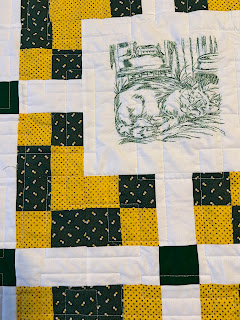Jacket 8 – Done
The jacket is finished! (Picture 8-1)
Picture 8-1It took me about 6 weeks to complete. I only worked on it for about two hours a day for three or four days each week. In total, I think I probably have about 40 hours of work. I like to work in the morning when the sun is bright in my east-facing sewing room. Old eyes and old hands don’t work as well later in the day. Each day I would decide which “chunk” of the project to tackle – usually the next paragraph of my tailoring book. When my efforts didn’t go as hoped or I had too much trouble (like the day I could not thread the needle), I quit for the day and started again the next day. Big projects are not so overwhelming when broken down into smaller steps.
As I went along, I had a chance to review techniques I
thought I knew and learned how to improve my application of them – grading
seams, buttonholes, etc. I also found
explanations for “rules” I didn’t always understand, such as, press the seam
flat first; how to press the armhole
seam.
I also discovered some things about several of the products
I chose to use. In my earlier efforts at
making men’s jackets, the undercollar was always a challenge. The tailoring book suggested using felt but
good felt (way back then, pre-internet) was hard to fine. This time, when I found the ready-made undercollar
fabric, it seemed the way to go. It did
save me the work of pad-stitching the undercollar and I didn’t have to be
concerned with pressing the undercollar seams to the wrong side as I would have
with a fabric undercollar. But it had
its own challenges: the hair canvas
threads kept appearing at the edges of the trimmed piece; it took the curve
well but then didn’t want to “uncurve” to be fit to the upper collar for sewing;
it does not stretch easily and shaping took a lot of steam.
Another new product I found was cotton edge-tape. It is a rigid ½ inch tape that is used to
stabilize the roll-line and front edge of the jacket. It is stable – no stretch at all. This worked well on the straight edges, like
the roll-line and the front edge, but not so well on curves like the armhole. This tape would not go around even a gentle
curve. I found I needed bias twill tape
for the armhole and neck seams.
I also found that in addition to new pins and needles, several old and new tools were very helpful (Picture 8-2).
Picture 8-2
One old tool was the little 6-inch sliding sewing gauge. I used it constantly to measure and mark seam allowances. As usual, it wandered around my sewing table getting covered up with fabric, books and other sewing essentials. The new tailor chalk was also very useful for marking critical points. The tailoring site suggested using Rabbit Brand disappearing chalks – 50 pieces to a box! I had no need for 50 pieces, so I bought tailor chalk from Amazon. The white chalk did disappear with heat, but the other colors did not. Substitutes may not always be as good as the professionally recommended product.
Pressing tools are essential. In addition to the pressing ham, the “totally
tubular pressing station” from DIME (a birthday present from my husband) made
pressing seams, darts, etc. easier. I
used it to press the sleeve seams on the narrow board, flipped it over to press
the facings and roll-lines. With a wool
pad, the steam penetrated the fabric and I had nice sharp creases. (Picture 8-2) I needed a lot of steam when
pressing the lapels and collar. I placed an old-fashion white flour sack dish towel over the area to be pressed and wet the
towel with a squirt bottle of water; applied the iron and swoosh, steam to fog
my glasses!
The amount of thread I used surprised me. I had three standard spools of Gutermann
thread. Two are almost totally used. Each spool had 110 yards which I think is
less than on older spools. In the past,
I always thought two spools would be more than enough for even a large project. I also had a spool of Tire silk thread and
use a good part of that for the buttonholes.
The jacket is completed and waiting for the first occasion
for wearing it. (Picture 8-1) I took
several days to sort and straighten up my sewing area. The question now, is what to do next? Maybe some smaller projects like a wall
hanging or doll dress while I contemplate the next major project. Or maybe I’ll focus on knitting for a while –
I have been thinking about socks.
* Note - This is the last post in a series by Sandy Herman about making a man's tailored jacket.




Sandy, you are an amazing woman! What a delight it has been to journey along with you as you have created this stunning jacket! I have learned a lot from your blog posts, and have really enjoyed reading about all that you went through to bring this garment to fruition. Congratulations!
ReplyDeleteElizabeth Davis
These articles are very well written and very informative. Great job, Sandy.
ReplyDelete